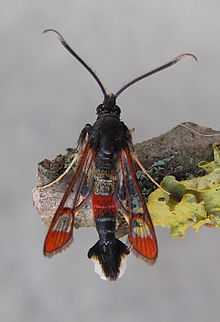Synanthedon formicaeformis
| Synanthedon formicaeformis | |
|---|---|
 | |
 | |
| Scientific classification | |
| Kingdom: | Animalia |
| Phylum: | Arthropoda |
| Class: | Insecta |
| Order: | Lepidoptera |
| Family: | Sesiidae |
| Genus: | Synanthedon |
| Species: | S. formicaeformis |
| Binomial name | |
| Synanthedon formicaeformis (Esper, 1783)[1] | |
| Synonyms | |
| |
The Red-tipped Clearwing (Synanthedon formicaeformis) is a moth of the Sesiidae family. It is found in all of Europe, the eastern Palearctic ecozone and the Near East.[2]
The wingspan is 17–19 mm. Adults have clear wings, which are covered in scales only on the wing veins, the discal area and the wing edges. They have reddish patches at the tips of the forewings.[3] The forewings are reddish coloured on the edges. The fringes are brownish. The discal stain is crescent-shaped, olive or reddish brown and extends from the front to the back edge. The hindwings have a narrow dark edge, as well as a small black-brown discal stain. The antennae, head, thorax and abdomen shine blue black. A red ring is located respectively on the fourth and fifth segment of the abdomen. Sometimes, also the sixth segment is reddish in colour. The hind tufts are strongly fan shaped, blue-black in colour, clear yellowish white on the sides.
Adults are on wing from May to July, at higher elevations until August. They are particularly active in the sunshine and visit the flowers of different plants, such as those of elderberry Sambucus nigra, Origanum vulgare, Jacobaea vulgaris, Ligustrum vulgare and Rubus idaeus.
The larvae feed inside the stems of various Salix species of, including Salix viminalis.They prefer injured, sick or elderly trees.The larvae overwinter and pupate in the spring under the bark of the food plant.
References
| Wikispecies has information related to: Synanthedon formicaeformis |
| Wikimedia Commons has media related to Synanthedon formicaeformis. |